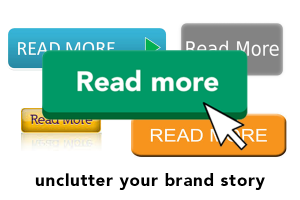The tactical wisdom of [READ MORE]
Every marketing communication must navigate between two dangers: saying too much, or saying too little.
The more common error is saying too much, stressing too many benefits in an avalanche of words. (“Too many notes, Mozart.”)
It’s a frequently fatal fear: Your prospect might not fully grasp the many compelling wonders of your brand unless you hammer home all of them and right now dammit. This urge fails if the suspect bails out, never to become a prospect.
Might you be just a tiny bit guilty of this strategic error? Take this test to score yourself: look at your home page (or About Us page, or the latest issue of your newsletter, or maybe that sales brochure). Examine the very first paragraph; count how many lines of type are there.
One to three? Congrats. Four to six? Careful, my friend. More than six? Oops. You turned off a big chunk of your potential readers at their first glance. Research tells us a paragraph of seven lines disinvites the eye, signaling an effort will be required to read your text. Many, including educated adults, find that daunting.
No, it doesn’t matter that it’s thoughtful, rational, witty and/or persuasive. If that opening block of type seems “texty,” these readers will not even start.
A more eye-inviting short paragraph is far more likely to get the reader into motion. If it’s good storytelling, you’ll keep them, and move them along the buyer’s journey.
But what about prospects who insist on learning more more more about what you have to say? The ones who want to understand your process, not just results? The ones who do research and examine specifications? The ones who hear your brand benefit story and say “prove it”? We call these skeptical folk Quants, by the way. They’re one-seventh of the human race and so can’t be ignored. 1/7 of 7 billion people on earth is, if I can do the arithmetic, a considerable tribe.
That’s why you must use and celebrate READ MORE strategies, synecdoche and drill-downs, plus follow-up communications that arrive only when they’re needed and wanted.
Put your single most compelling brand idea front and center to satisfy and compel interest for six-sevenths of humanity, the Quals, then use these three valuable tactics to persuade the Quants.
• READ MORE is a way to de-clutter your digital messaging, to make your opening copy hook stand out.
• Synecdoche is a lovely word*, isn’t it? This figure of speech is “a part that represents the whole,” a way to magnify the small gestures and results that speak to larger issues. It helps you avoid impotent generalities, such as “we have great customer service.” That’s an unoriginal, overused and not terribly credible claim, compared to say, free donuts in the waiting area, a hot towel with the haircut, or we’ll send you both sizes of shoe and you can just return the ones that don’t fit. Small, tangible, visceral, genuine truths speak to larger truths to craft a powerful brand narrative.
• Drill-downs (both pages and scroll-down matter below the fold) can supply Quants with the exhaustive information they thrive on, while not cluttering up the brand story for the Quals, who demand less. But will your audience patiently scroll down, or click to get the additional proof they demand? In fact, yes, they will.
We strongly recommend these three methodologies to all marketers, especially in digital marketing. Your prospect is one twitching finger away from discarding you if you don’t address her needs. Anticipate them.
Want to talk about it?
*sin-EK-do-kee. Robert Frost defined his poetry as the work of a synecdochist.